Old Galway
The Salmon Weir Bridge
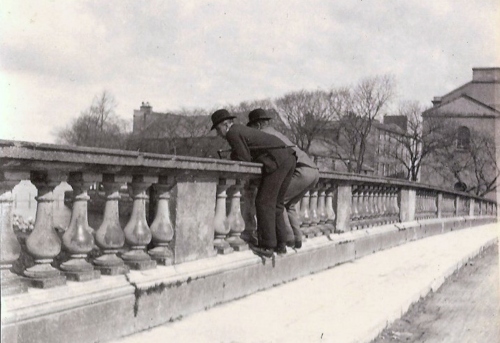
by Tom Kenny
The original purpose of the structure that is the Salmon Weir Bridge was to connect the New County Courthouse with the County Gaol on Nun’s Island. Urban folklore has it that they built a tunnel under the river at the time in order to transfer prisoners from one building to the other, but why would they construct a crossing over and under the water at the same time. It does not make sense. The building of the seven span bridge started in 1818 and finished in 1819.
THE GALWAY GENERAL OMNIBUS COMPANY

by Tom Kenny
The first regular public transport service in Galway was run by the Galway and Salthill Tramway Company which started business on October 1st, 1879 and which by 1885 was being used by in excess of 105,000 passengers per year. During the First World War, most of the company’s best horses were commandeered by the British Army and there was more and more competition from motorised vehicles, so the tramway ceased trading in April 1918.
COUNTY INFIRMARY
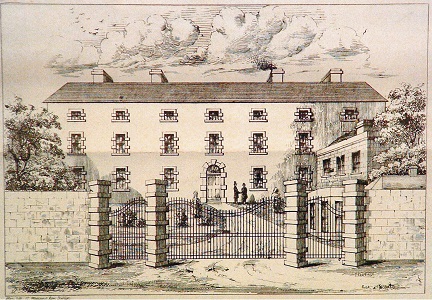
by Tom Kenny
A meeting of the Corporation held on April 17th, 1766 decided that “A committee consisting of the principal gentlemen of the town, be, and are accordingly appointed to inquire and find out a proper place within the county of the town of Galway for erecting a public infirmary or hospital for the reception of the poor, sick and disabled persons”.
SNOW COVERED SALTHILL
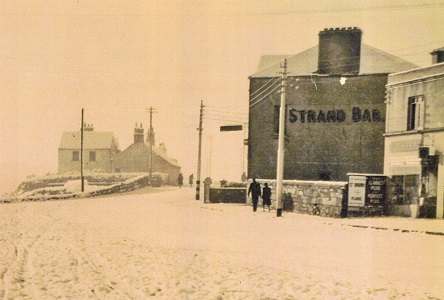
by Tom Kenny
This wintry photograph of part of Salthill was probably taken during the war as there are no vehicle tracks in the snow, indeed there are no vehicles to be seen. The shop on the right was built by a Miss Burke who came here from Castlerea in 1935. It was a grocery and sweet shop with advertisements on the wall outside for plug tobacco.
The stone wall beside it fronted a vacant site where Claude Toft eventually built his amusements arcade and casino. Claude was one of Salthill’s great characters who would eventually become mayor of Galway.
BANKS CASTLE

by Tom Kenny
We came across this drawing in the National Library titled “A narrow street in Galway, c.1840-1850”. The Clue is in the handwriting at the top of the image, ‘Castle Bank’. In fact, it was a courtyard, not a street, looking at the back of Banks Castle off High Street. Our photograph (courtesy of the Chetham Library in Manchester), shows us much the same view about 25 years later. The property is now part of the King’s Head.
Galway Courthouse c1870
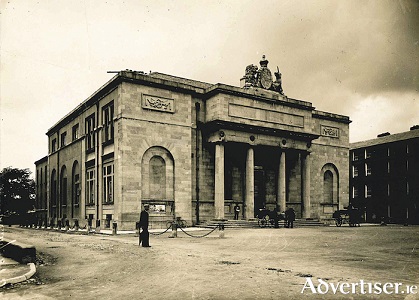
by Tom Kenny
“This fine building, which is superior to most provincial seats of justice, stands at Newtown-Smith, on the site of the ancient and venerable abbey of the Franciscans, which by the Charter of Charles II ‘is to be and remain part of the County of Galway forever’. It was commenced in 1812, and on 1st of April, 1815, was opened for the reception of the then going judges of assize.
THE BISH LEAVING CERT CLASS OF 1960
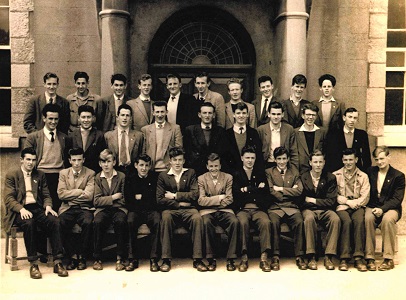
by Tom Kenny
The distinguished historian Gerry Hayes McCoy, a graduate of the Bish, once wrote of his Alma Mater “Going to school is the greatest emotional experience of a lifetime, the greatest and least forgettable. Do you remember how the sun shone through that wire-meshed window, shone in on your childhood, the bright sun of long ago? Do you smell again the smell of school—warm, varnish, leather, bread & butter, ink, powder, books, boys? Do you remember the flinty yard, tree-shaded; the speaking river; the screaming seagulls on a frosty morning? How cold could it be! Do you remember the lighting of the fire—how it smoked without heat, how it smouldered. Do you remember the wonderful morning when the key of the school was lost and who-was-it was sent up town to the shop where –how unsporting—they kept a box of keys to thwart just so delirious a possibility.”
FIRST STEAMBOAT ON GALWAY BAY

by Tom Kenny
“The Citie of the Tribes” was the name given to the first steamboat to sail on the bay. She was built in South Shields and registered on December 24th, 1872 for the pioneering Galway Steamboat Company and her arrival here was hailed as the precursor of the new shipping millennium, the era of steam. There was not another steamship to be seen in the harbour and the old sailing salts worried about the advent of the “Iron ships and Wooden men” as opposed to the great sailing days of the “Wooden ships and Iron men”. She was a paddle tug about 96’x18’x9’ and was involved in towing barques and other sailing vessels to and from Galway Port, often going many miles west of the islands with outbound vessels.
.png)